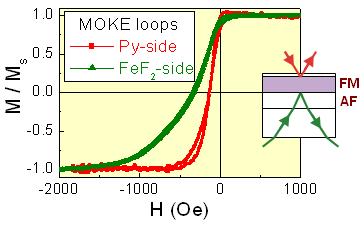
The hysteresis loop of ferromagnetic/antiferromagnetic (FM/AF) thin films exhibits a shift along the magnetic field axis below the Néel temperature (TN) of the AF known as exchange bias field, HEB (Fig. 1). The origin of exchange bias (EB) is the coupling between FM and AF spins at the interface. This effect is a hot topic in Condensed Matter Physics owing mainly to two reasons. First, it has a significant importance in industry for giant magnetoresistance devices, like hard disk hard drive read heads, where the AF/FM interaction is used to control the reversal of FM multilayers. Second, due to the lack of experimental techniques to investigate the AF/FM interface, the microscopic details of EB are poorly understood. [1]
Our experiments aim to shed light on the microscopic origin of EB. We use SQUID and VSM magnetometry, magneto-optical Kerr effect, resonant x-ray scattering, polarized neutron reflectometry, and pulsed laser techniques [2] to investigate the EB effects in FeF2/FM thin films. This system (with TN=78K) shows particular features.
- Low cooling fields yield negative EB while high cooling fields yield positive EB. [3]
- Double hysteresis loops are observed at intermediate cooling fields for high quality epitaxial FeF2 (Fig. 2). [4]
- The exchange interaction at the AF/FM interface induces a magnetic depth profile through the thickness of the FM and changes in the magnetization reversal process (Fig. 3) [5-7]




[2] A. Porat, S. Bar-Ad, and Ivan K. Schuller, Euro. Phys. Lett. 87, 67001 (2009)
[3] I. V. Roshchin et al. Europhys. Lett. 71, 297 (2005)
[4] O. Petracic et al. Appl. Phys. Lett. 87, 222509 (2005)
[5] S. Roy et al. Phys. Rev. Lett. 95, 047201 (2005)
[6] Z-P. Li et al. Phys. Rev. Lett. 96, 217205 (2006)
[7] R. Morales et al. Appl. Phys. Lett. 89, 072504 (2006)
[8] Ivan K. Schuller, Mat. Res. Soc. Bull. 29, 642 (2004)
